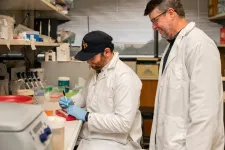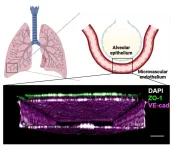(Press-News.org) Sleeping patterns and stress hormones could be the key to understanding how and when people with epilepsy are likely to experience seizures, a new study reveals.
Researchers used mathematical modelling to understand the impact of different physiological processes, such as sleep and changes in concentration of the stress-hormone cortisol, on key signatures of epilepsy – known as epileptiform discharges (ED).
Epilepsy is a serious neurological disorder characterised by a tendency to have recurrent, spontaneous seizures. Classically, seizures were assumed to occur at random, until the discovery of ED activity with timescales that vary from hours and days through to months.
The scientists analysed 24-hour EEG recordings from 107 people with idiopathic generalized epilepsy and discovered two subgroups with distinct distributions of epileptiform discharges: one with highest incidence during sleep and the other during daytime.
Publishing their findings in PLOS Computational Biology, the international research team led by the University of Birmingham, reveal that either the dynamics of cortisol or sleep stage transition, or a combination of both, explained most of the observed distributions of ED.
Lead author Isabella Marinelli, from the University of Birmingham’s Centre for Systems Modelling & Quantitative Biomedicine (SMQB), commented: “Some 65 million people have epilepsy worldwide, many of whom report specific triggers that make their seizures more likely - the most common of which include stress, sleep deprivation and fatigue.
“Our findings provide conceptual evidence that sleep patterns and changes in concentration of cortisol are underlying physiological drivers of rhythms of epileptiform discharges. Our mathematical approach provides a framework for better understanding what factors facilitate the occurrence of ED activity and potentially trigger the seizures which can be so debilitating for epilepsy sufferers.”
The researchers’ mathematical model describes the activity of connected brain regions, and how the excitability of these regions can change in response to different stimuli - either transitions between sleep stages or variation in concentration of cortisol.
ED frequency increases during the night, early in the morning, and in stressful situations in many people with epilepsy. The team discovered that sleep accounted for 90% of variation in one subgroup and cortisol around 60% in the other subgroup.
Cortisol is one of the primary stress hormones in humans, with production and secretion controlled by the hypothalamic-pituitary-adrenal (HPA)-axis. In stressful situations, HPA-axis activity increases, resulting in a higher secretion of cortisol.
“Sleep alone cannot account for the changes in ED likelihood during wakefulness observed in our first subgroup,” explained Dr Marinelli. “There is a reduction in ED likelihood during the sleep time after an initial sharp increase during the first hours.
“This can be explained by the fact that deep sleep, which is linked to an increase of EDs, is predominant during the first third of the sleep period. We found an increase in ED occurrence before waking, which - given that the level of cortisol is known to increase around waking - suggests a combined effect of sleep and cortisol.”
ENDS
For more information, interviews or an embargoed copy of the research paper, contact Tony Moran, International Communications Manager or call +44 (0)7827 832312 email t.moran@bham.ac.uk or pressoffice@contacts.bham.ac.uk
Notes for editors
The University of Birmingham is ranked amongst the world’s top institutions, its work brings people from across the world to Birmingham, including researchers and teachers and more than 8,000 international students from over 150 countries.
‘Circadian distribution of epileptiform discharges in epilepsy: Candidate mechanisms of variability’ - Isabella Marinelli, Jamie J. Walker, Udaya Seneviratne, Wendyl D’Souza, Mark J. Cook, Clare Anderson’, Andrew P. Bagshaw, Stafford L. Lightman, Wessel Woldman, and John R. Terry is published in PLOS Computational Biology.
Participating institutions include: University of Birmingham, UK; University of Exeter, UK; University of Melbourne, Australia; Monash University, Australia; and University of Bristol, UK.
The Centre for Systems Modelling and Quantitative Biomedicine (SMQB) is a unique interdisciplinary collaborative spanning mathematics, computer science and medicine. It was established in 2019 through a strategic investment of £7 million by the University of Birmingham (www.birmingham.ac.uk/smqb). END
Sleep and stress give clues to understanding epileptic seizures - study
2023-10-17
ELSE PRESS RELEASES FROM THIS DATE:
The Dompé Foundation launches 16 scholarships for neuroscience and neurobiology students in the US
2023-10-17
The Dompé Foundation is offering 16 scholarships to support neuroscience and neurobiology students enrolled at US universities for the academic year 2023/2024. This funding opportunity, which honors the legacy of the only female Italian Nobel laureate in Medicine, is intended for promising candidates from any nationality that have already been admitted to a Master’s, PhD or post-doc program. With a total budget of up to about 1 million USD, the Foundation has doubled from the previous two years its funding for the US project, ...
NASA September 2023 temperature data shows continued record warming
2023-10-17
Continuing the temperature trend from this summer, September 2023 was the hottest September on record, according to scientists at NASA’s Goddard Institute for Space Studies (GISS). The month also set the record for the highest temperature anomaly – the largest difference from the long-term average.
This visualization shows global temperature anomalies along with the underlying seasonal cycle. Temperatures advance from January through December left to right, rising during warmer months and falling during cooler months. The color of each line represents the year, with colder purples for the 1960s and warmer oranges and yellows for more recent ...
Researchers test seafloor fiber optic cable as an earthquake early warning system
2023-10-17
One of the biggest challenges for earthquake early warning systems (EEW) is the lack of seismic stations located offshore of heavily populated coastlines, where some of the world’s most seismically active regions are located. In a new study published in The Seismic Record, researchers show how unused telecommunications fiber optic cable can be transformed for offshore EEW.
Jiuxun Yin, a Caltech researcher now at SLB, and colleagues used 50 kilometers of a submarine telecom cable running between the United States and Chile, sampling ...
Researchers receive NIH grant to improve quality of life for people with Down syndrome
2023-10-17
A team of researchers at the Texas A&M University School of Veterinary Medicine & Biomedical Sciences (VMBS) has received a grant from the National Institutes of Health (NIH) to research metabolism in people with Down syndrome.
By targeting genes that affect metabolism, the team may be able to develop drug therapies for physical and mental symptoms of the condition, like muscle loss, accelerated aging, and lower cognitive function, thereby improving the quality of life for people with Down syndrome.
The new grant will also make Dr. Weston Porter, a professor in the VMBS Department of Veterinary Physiology & Pharmacology and lead researcher ...
Miniaturized FSO breakthrough unlocks high-speed wireless communication anywhere
2023-10-17
In a world that relies on high-speed internet and seamless communication, the absence of a reliable fiber connection can be a significant hurdle. Fortunately, a cutting-edge technology known as free-space optical communication (FSO) offers a flexible solution for field-deployable high-speed wireless communication in areas where fiber connections are unavailable.
FSO has garnered attention for its versatility across various scales of operation. On a global level, it plays a crucial role in establishing high-speed satellite internet projects like Starlink, ensuring global connectivity. At the ground level, ...
Pennington Biomedical’s Dr. Leanne Redman selected for top honor by The Obesity Society
2023-10-17
BATON ROUGE – The Obesity Society – the leading professional society focused on obesity science, treatment and prevention – has named Pennington Biomedical’s Dr. Leanne Redman as the recipient of the 2023 TOPS Research Achievement Award. The award, which is funded by the Take Off Pounds Sensibly, or TOPS, Foundation, was presented to Dr. Redman on Monday, Oct. 16, in recognition of her contributions to research in the field of obesity.
Considered by many to be the top award for obesity research, Dr. ...
New technique helps robots pack objects into a tight space
2023-10-17
CAMBRIDGE, Mass. -- Anyone who has ever tried to pack a family-sized amount of luggage into a sedan-sized trunk knows this is a hard problem. Robots struggle with dense packing tasks, too.
For the robot, solving the packing problem involves satisfying many constraints, such as stacking luggage so suitcases don’t topple out of the trunk, heavy objects aren’t placed on top of lighter ones, and collisions between the robotic arm and the car’s bumper are avoided.
Some traditional methods tackle this problem sequentially, guessing a partial solution ...
Mitochondrial protein plays key role in glioblastoma and therapeutic resistance
2023-10-17
Glioblastoma is the most common type of brain tumor that affects adults and, unfortunately, still remains incurable. In a new study, researchers have demonstrated that a specific mitochondrial protein plays an important role in glioblastoma, and can therefore be used as a potential target to reduce tumors.
“Glioblastoma is notorious for its lethality. One of the major challenges is that it spreads invasively throughout the brain. We’re interested in understanding what drives this process in order to identify new therapeutic strategies,” said Brendan Harley (RBTE leader/EIRH), the Robert W. Schaefer Professor of Chemical ...
Whaling wiped out far more fin whales than previously thought
2023-10-17
Key takeaways
Whaling in the 20th century destroyed 99% of the Eastern North Pacific fin whale breeding population.
Because there is enough genetic diversity, current conservation measures should help the population rebound without becoming inbred.
The future of fin whales in the Gulf of California depends on the recovery of the Eastern North Pacific population.
A new genomic study by UCLA biologists shows that whaling in the 20th century destroyed 99% of the Eastern North Pacific fin whale breeding, or “effective,” population — 29% more than previously thought.
But there is also some good news: Genes among members of this endangered ...
Human Lung Chip leveraged to faithfully model radiation-induced lung injury
2023-10-17
By Benjamin Boettner
(Boston) — The lung is one of the tissues most sensitive to radiation in the human body. People exposed to high radiation doses following nuclear incidents develop radiation-induced lung injury (RILI), which affects the function of many cell types in the lung, causing acute and sustained inflammation, and in the longer term, the thickening and scarring of lung tissue known as fibrosis. RILI also is a common side effect of radiation therapy administered to cancer patients to kill malignant cells in their bodies, and can limit the maximum radiation dose doctors can use to control their ...






